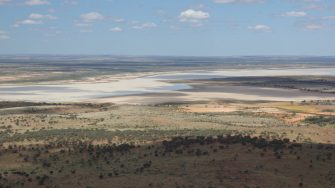
Date: Thursday, October 13, 2016
Project: Eastern Australian Waterbird Survey
Observer: Richard Kingsford
We decided on an early start today to capitalise on the cool conditions.
Plane is loaded and ready to go at dawn at William Creek
Flying over Lake Eyre and its drying patches of water in the early morning was sublime. This vast landscape stretching in every direction with its subtle white, grey and red colours. We then headed directly for the most westerly point of Band 5, Lake Frome. This band stretches all the way to the Bellinger River which we surveyed nine days ago. A lot of water under the plane since then.
Flying over Lake Eyre in the early morning
Lake Frome, our first survey point, is just northeast of the spectacular Flinders Ranges
Lake Frome is a massive salt lake, northwest of Broken Hill. There was just a smear of water across it, nothing that would interest any waterbirds. Unsurprisingly, not a waterbird to be seen.
Surveying Lake Frome
There are about a dozen ephemeral salt lakes, just east of Lake Frome. Nearly every year these are dry but this year they had obviously had some local rainfall. Their bright blue colour was a giveaway to their salinity. As with most of these lakes, they tend to be too saline to support many waterbirds, apart from the odd red-necked avocet.
Surveying the salt lakes east of Lake Frome
From here, after crossing the Silver City Highway between Tibooburra and Broken Hill, there are about thirty small lakes, swamps and claypans which can be exhausting to survey as the plane goes back and forth. Even with only about 20% of them with some water, it was tiring work. Few waterbirds here, as has been the pattern. We lunched in the opal town of White Cliffs before heading off to survey the Paroo overflow lakes, another favourite of mine. The Paroo River here was on show with all of its vast floodplain and lakes. And we were only doing it across a relatively narrow band of 30 km.
Peery Lake
First, we surveyed Peery Lake, part of the Paroo-Darling National Park. It was only about 30% full with all the water up the northern end. Given that it fills from the Paroo River from its southern end, this water probably came from local catchment flows. It was very shallow but, the ubiquitous nesting avocets were dotted along the shoreline. They must get it wrong sometimes when a flood comes in and swamps their nest. It also seems very risky nesting on small pieces of ground in the middle of what could be a deep lake. These areas would easily be submerged if the lake was even a quarter full.
The shallow water is not even sufficient to submerge vegetation in Peery Lake
We then had the full series of Paroo overflow lakes to survey, including Olepoloko, Gilpoko, Yantabangee, Mullawoolka Basin, Tongo Lake and Green and Blue Lakes. We must have spent at least half an hour flying back and forth. There was a reasonable amount of water, but not many birds. The most interesting observation was of the swans nesting on small islands on Tongo Lake. Obviously successful because there were also plenty of swan broods around.
Surveying the north-south Mullawoolka Basin
After we had done these lakes, we headed west across the labyrinthine channels of the Paroo. These intertwine across a huge area, bringing water from the north both from the Paroo River and the Warrego River, through Cuttaburra Creek. Not all of the channels had water – the locals have called this a ‘small but good flood’. All floods are highly beneficial in these inland areas because they bring so much productivity to the landscape.
Channels spread out in all directions on the floodplains of the Paroo River, just east of White Cliffs
Our final surveys were along the Darling River. We started just south of the town of Louth and headed northeast until we were just south of Bourke. It was great to see a decent flood going down the Darling. In places there was so much water in the river that it had started to creep out onto the floodplain. These floodplains need a good flood every now and again to sustain the coolibah trees. Water developments upstream have meant the floods to these areas are less frequent and less extensive. According to our Bourke taxi driver, this was a 10m flood in the river, as opposed to the 13 m flood in 2012. A pretty good flood.
A ‘pretty good’ flood on the Darling River
